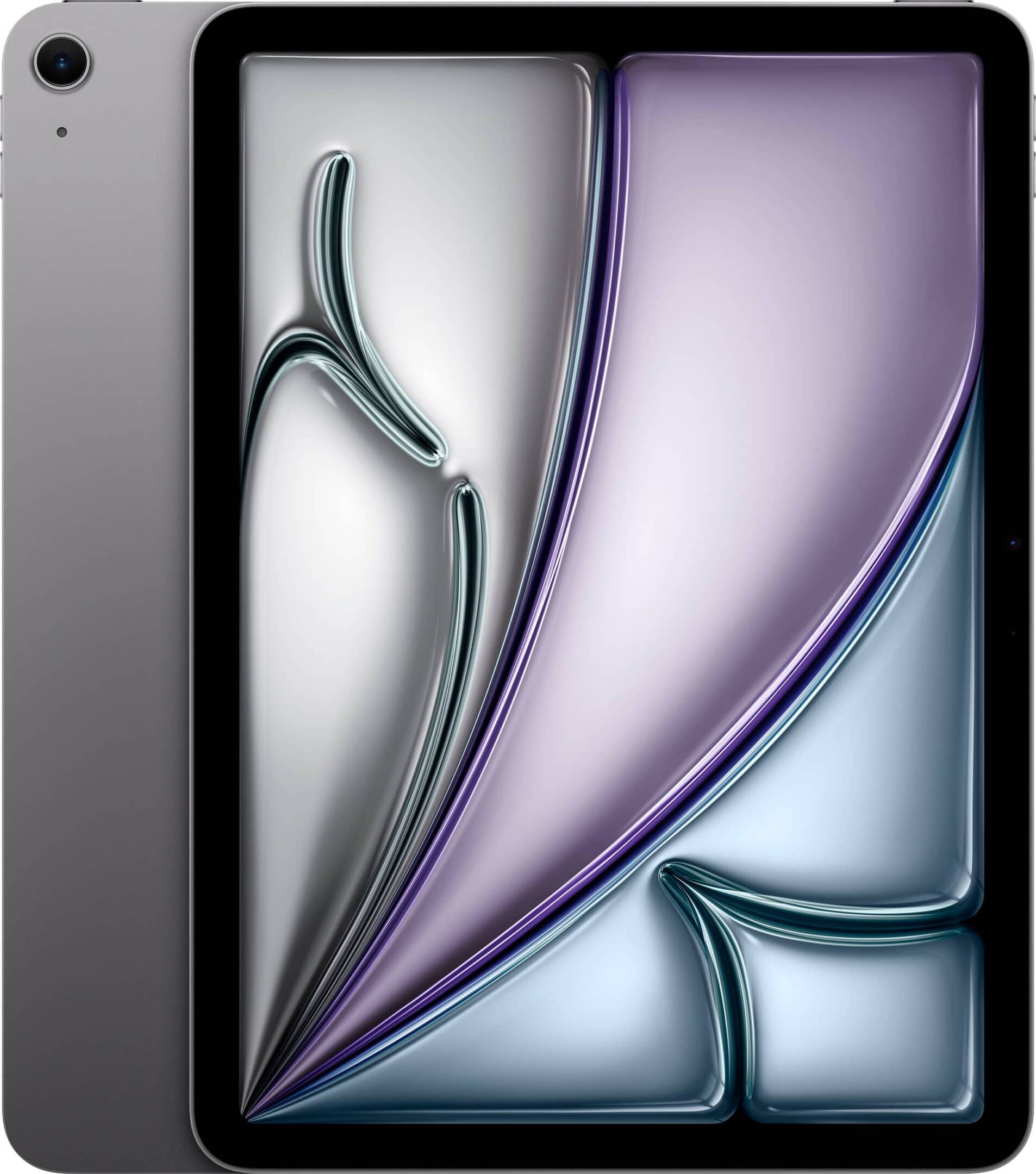Apple is gearing up for significant upgrades to its iPad Air and entry-level iPad models in 2025, with industry insiders pointing to major performance enhancements driven by next-generation chips. These updates are expected to bring notable improvements in speed, efficiency, and functionality, marking a pivotal step in Apple’s ongoing efforts to maintain its dominance in the tablet market. As competitors like Samsung and Lenovo push their own high-performance devices, Apple’s move underscores its commitment to staying ahead with cutting-edge technology.
The expected upgrades are:
- iPad Air Getting The M3 Chip (Previously On The M2 Chip)
- iPad 11th Generation Getting The A17 Pro chip (Previously On The A14 Bionic chip)
The iPad Air: Powered by the M3 Chip

Reports indicate that the upcoming iPad Air will feature Apple’s powerful M3 chip, a notable leap from the current M2 architecture. The M3 chip, which debuted in the latest MacBook models, is built on a 3-nanometer process, delivering better energy efficiency, faster CPU performance, and significantly improved GPU capabilities. For professionals and creatives, this upgrade could translate into smoother multitasking, faster rendering of high-resolution media, and improved compatibility with advanced apps like Final Cut Pro and Adobe Photoshop.
Additionally, the iPad Air is rumored to come in two sizes: the familiar 11-inch version and a new 13-inch variant, catering to users who desire more screen real estate for productivity and content consumption. This marks the first time Apple has introduced size variations within the iPad Air lineup, signaling a broader strategy to diversify its product offerings.
Entry-Level iPad: A17 Pro for Better Performance
The entry-level iPad, often the most popular choice for casual users and educational purposes, is also set for a significant upgrade. Sources suggest it will adopt the A17 Pro chip, currently seen in the iPhone 15 Pro models. The A17 Pro, manufactured using the same 3-nanometer technology as the M3, offers up to 20% faster GPU performance and improved neural engine capabilities.

These enhancements could enable the next-generation entry-level iPad to support more advanced applications, including augmented reality (AR) features, educational software, and even some light gaming. The improved performance will likely make the iPad more competitive in the budget tablet market, where devices like Samsung’s Galaxy Tab A series and Amazon’s Fire tablets have gained ground.
Why This Upgrade Matters
Apple’s decision to refresh its iPad Air and base iPad models with these advanced chips is strategic. In recent years, the tablet market has evolved from being a supplementary gadget to a primary device for many users. Remote work, online learning, and creative industries have driven demand for tablets that can rival traditional laptops in performance.
With the M3 and A17 Pro chips, these iPads will not only run everyday applications more smoothly but also handle demanding tasks like video editing, graphic design, and interactive educational content with greater ease. The inclusion of more RAM—potentially up to 8GB in the base model—could further enhance multitasking capabilities, making these devices more versatile for both students and professionals.
Potential Software Enhancements
Beyond the hardware, these new iPads might also come with software upgrades tailored to leverage the improved performance. iPadOS 18, expected later this year, is rumored to introduce more AI-driven features under Apple’s “Apple Intelligence” initiative. This could mean smarter Siri interactions, better handwriting recognition with the Apple Pencil, and more intuitive app integrations.
Market Impact and Consumer Expectations
The anticipated iPad upgrades arrive at a time when tablet sales have been relatively stagnant. IDC reports a global decline in tablet shipments, with many consumers holding onto their devices for longer periods. By introducing more powerful chips, larger screen options, and enhanced AI capabilities, Apple aims to rekindle consumer interest and maintain its lead over Android-based competitors.
For potential buyers, these upgrades make the 2025 iPad lineup more compelling than ever. Whether you’re a student attending virtual classes, a creative professional editing videos on the go, or a casual user streaming content, the performance and efficiency gains from the M3 and A17 Pro chips promise a smoother, more responsive experience.
As Apple prepares for an expected spring release, all eyes will be on these refreshed models to see if they can live up to the growing anticipation. With its track record of delivering seamless hardware-software integration, Apple seems poised to redefine the tablet experience once again in 2025.
Key Takeaways
- Apple is enhancing iPad Air and entry-level iPads with new processors.
- Processor upgrades are set to improve device speed and efficiency.
- Anticipated updates may significantly boost performance for users.
Upcoming Enhancements to the iPad Air and Entry-Level iPad
Apple is poised to boost the performance of both the iPad Air and Entry-Level iPad with new processors, promising faster speeds and greater efficiency. These advancements set a high bar for rivals, while maintaining Apple’s dominance in the tablet market. Enhanced features surpass basic processing improvements, offering a richer user experience.
Revolutionized Performance with New Chips
The iPad Air is expected to incorporate the M3 chip, delivering significant upgrades from previous models. This chip focuses on improved graphics performance and power efficiency. Users should notice faster app launches and smoother multitasking experiences.
On the other hand, the Entry-Level iPad is likely to feature the A17 Pro chip. This inclusion would enhance everyday tasks such as web browsing and video streaming, making the device more appealing to students and casual users. Improved battery performance is a critical aspect of these updates, ensuring prolonged device usage without the need for frequent charging.
Comparative Analysis with Previous Generations
The leap from the M1 to the M3 chip in the iPad Air represents a substantial performance gain. Users of the older M1-equipped variants will benefit from more refined graphics capabilities and increased processing speed, making demanding applications like video editing more accessible. The A17 Pro chip in the Entry-Level iPad promises to bring features previously exclusive to higher-tier models.
Features such as Touch ID, 5G connectivity, and Center Stage have been consistent, but with enhanced processing power, their functionalities are expected to be even more seamless. Existing users will witness noticeable improvements without any compromise on the sleek design and portability.
Anticipated Features Beyond Processing Capabilities
While the focus is on processing power, other enhancements are also expected. Apple may integrate improved front-facing cameras with better low-light performance, offering clearer video calls and photos. The addition of Apple Pencil support positions the iPad Air for creative tasks, transforming it into a viable alternative for digital artists.
Magic Keyboard compatibility might also extend to both models, facilitating a laptop-like experience ideal for productivity. Existing features such as Split View for multitasking could be optimized to take full advantage of the increased processing power, making it easier to switch between applications efficiently and effectively.
Industry Impact and Consumer Expectations
The expected updates to the iPad Air and entry-level iPad are likely to reshape both market trends and user experiences. Industry observers anticipate significant advancements, particularly in regards to processing power and user interface enhancements.
Market Predictions and Technology Forecasting
Apple’s refreshed iPad lineup utilizing the A17 Pro chip signals a push toward enhanced computational abilities. This move is expected to influence the tablet market aggressively, encouraging competition among tech companies. The possibility of incorporating OLED displays and more robust processors may lead to a convergence of features often reserved for higher-end products seen in MacBook Air or even iPhone models.
Analyst Mark Gurman suggests that consumers can expect devices with capabilities nearing those of laptops but within more accessible pricing segments. The introduction of cutting-edge hardware may drive further adoption of iPads in sectors traditionally dominated by laptops or desktops, like education and content creation.
Enhancing User Experience with iPadOS
The new processors in the 11-Inch and 13-Inch iPad Air are anticipated to implement Apple’s suite of AI-driven features, improving multitasking and overall functionality. The synergy between these hardware updates and the latest iPadOS could enrich user interaction, offering smoother transitions between apps and enhanced productivity tools, including Magic Keyboards support.
Updates may also bring about refined use of Apple Pencil and enhanced accessibility features. This aligns with Apple’s strategy of integrating more intuitive user experiences across their devices, making the iPad lineup more appealing to consumers looking for a versatile, yet powerful, device.
Frequently Asked Questions
Apple is set to update the iPad Air and entry-level iPad with new processors, promising enhancements in performance and features. Users may have questions about the improvements, release dates, and potential impacts on existing models.
What are the new features to expect in the upcoming iPad Air and entry-level iPad models?
The updated iPad Air and entry-level iPad will likely feature improved processing power due to new chipsets. Enhanced battery efficiency and possibly better graphics capabilities may also be included. Users can look forward to smoother multitasking and possibly new functionalities that take advantage of the increased power.
Will the new processors in the iPad Air and entry-level iPad significantly improve performance?
The inclusion of newer processors is expected to offer substantial gains in speed and responsiveness. Applications that require higher processing power, such as graphic-intensive games or professional-grade apps, should see noticeably better performance. This update could also improve the overall fluidity of iOS operations.
How will the iPad Air update differ from the recent changes to the iPad Pro line?
While the iPad Pro often serves as a testing ground for Apple’s most advanced technologies, the iPad Air update will focus on bringing key performance enhancements without some of the high-end features of the Pro model. For instance, the Pro series might incorporate more advanced display technologies and additional sensors.
When is the expected release date for the updated models of the iPad Air and the entry-level iPad?
Apple typically announces new hardware in the spring or fall, with releases following shortly after. Based on past patterns, prospective buyers can anticipate an official announcement and subsequent launch within these timeframes. Potential buyers should stay tuned to Apple’s press releases.
What will be the price points for the new iPad Air and entry-level iPad with upgraded processors?
Although Apple has not announced pricing yet, any changes are likely to reflect those made in recent years. The addition of new processors might result in a slight price increase, but Apple also tends to keep their devices competitively priced within the market to appeal to a wide range of consumers.
How will the update to the iPad Air and entry-level iPad affect support for older iPad models?
Older models might not receive the same level of software support once new models are released. However, Apple generally provides software updates for several years after a device’s release. Users of older iPads should expect continued support, albeit potentially with limited new features.







